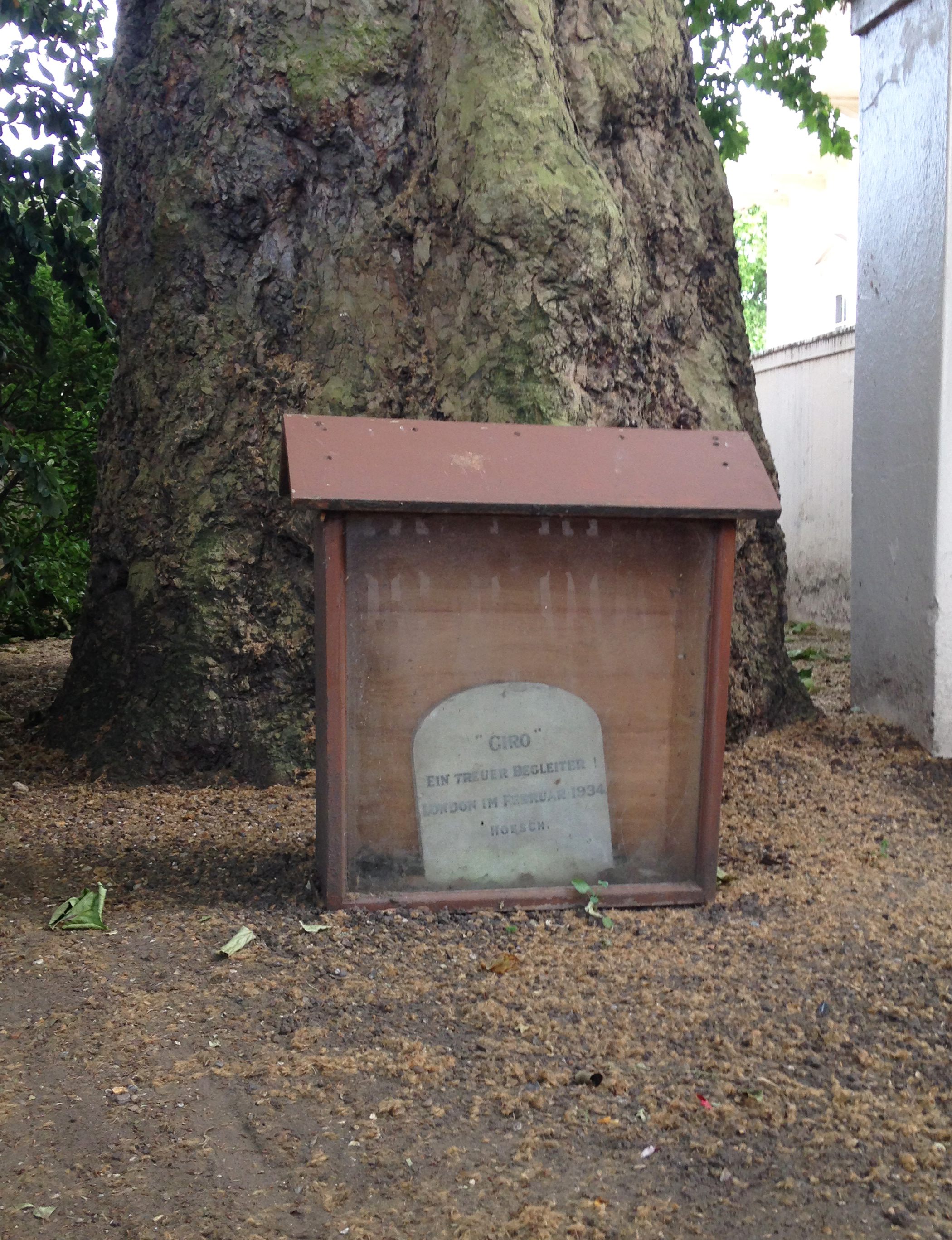London’s Hidden Memorial to a Nazi Dog
 The small and hidden grave of Giro. (Photo: Atlas staff)
The small and hidden grave of Giro. (Photo: Atlas staff)
At 9 Carlton Terrace in London sits a stately building. It’s a reserved white structure, appointed with columns within hailing distance from Buckingham Palace and St. James’s Park. But nestled among these grand offerings is a much smaller and stranger landmark that the average tourist speeds past en route to glitzier offerings.
Under a large tree, behind a fence, and next to a driveway is a tiny grave considered the only Nazi memorial in London. It’s the grave of a dog, Giro.

The German Embassy in the early 1930s, when Giro and Leopold von Hoesch were resident. To the left of the building is where Giro is now buried. (Photo: Bundesarchiv/WikiCommons CC-BY-SA 3.0)
In 1934, when Giro died, 9 Carlton Terrace was the German Embassy. The ambassador was Leopold von Hoesch, who began serving Germany as a statesman in 1923 under the Weimar Republic. An ambassador in Paris for several years, he was transferred to London in 1932, and transitioned to serving Hitler’s regime following the Nazi takeover in 1933. He would do so until his death three years later.
Von Hoesch was well suited to the role of ambassador; he was an independently wealthy world traveler who was photographed strolling London in a sharp suit, a pocket handkerchief, a cane and a hat. One historian wrote that the “urbane and sophisticated” von Hoesch entertained a visiting Nazi dignitary with a full Gypsy band at an intimate dinner. (The dignitary was Joachim von Ribbentrop, who would take over von Hoesch’s ambassadorship following his death and hang for war crimes in 1946.) But in addition to being adept at throwing parties and getting dressed, von Hoesch was also reportedly good at the political side of his job. He was “the greatest of the German professional diplomats of the interwar period” and London was where the “sensitive and devoted man proved himself a master of his craft,” according to one scholar.

Leopold von Hoesch in London, in 1932. (Photo: Bundesarchiv/WikiCommons CC-BY-SA 3.0)
Although von Hoesch served under the Nazi regime, it is believed he was not a supporter. One news article covering his death states “friends knew that he was completely out of sympathy with most of the principles of National Socialism.” It goes on to say his movements may have been tracked by Hitler’s spies and that it was rumored he “burst into tears” upon hearing of the “actions of the government he was attempting to serve.” Yet another article recording von Hoesch’s death declared he was “immune to the contagion of the violent, swashbuckling nationalism”.
Von Hoesch was also apparently devoted to his dog, Giro. Some accounts state that the dog was a terrier, but most name the dog’s breed as Alsatian, now called a German Shepherd. His death was sudden.

German inscription on Giro’s grave. (Photo: Atlas staff)
“Giro was electrocuted by an exposed wire in 1934,” writes Hannah Velton in her book Beastly London: A History of Animals in the City, “And his headstone reads ‘Ein Treuer Begleiter!’ (A True Companion!)”
The tombstone is plain and small.
Just two years later, von Hoesch would die suddenly, too. According to one account, he died while “reading his correspondence at breakfast at the German embassy.” Another states that he was dressing in his bedroom. In both cases, heart problems were named as the cause.
He was, according to the same story that claimed Nazi machinations brought him to tears, suffering.
“The ambassador had been under considerable mental and physical strain” states the April 11, 1936 story that ran in The New York Times. Photographs from that time showed the daper man to be a “bowed and shrunken figure”.
Despite von Hoesch’s less than enthusiastic endorsement for the dictatorship, he received a full Nazi funeral. On April 15, 1936 his coffin was draped in the Nazi flag and marched through the streets of London. British dignitaries attended and followed the large procession. Nineteen cannons were fired off in Hyde Park before the coffin was loaded onto a British destroyer that would deliver von Hoesch’s body back to German shores.
Already separated by death, Giro and his master were further marooned from each other by a body of water and contentious borders. The dog’s grave remains at 9 Carlton Terrace, an odd historical remnant appropriate for its strange owner.

(Photo: Atlas Staff)





Follow us on Twitter to get the latest on the world's hidden wonders.
Like us on Facebook to get the latest on the world's hidden wonders.
Follow us on Twitter Like us on Facebook